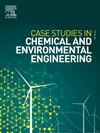Biotechnological strategy for tannery wastewater treatment: Bicarbonate/H2O2 oxidation integrated with microalgae cultivation
Q1 Environmental Science
Case Studies in Chemical and Environmental Engineering
Pub Date : 2024-12-12
DOI:10.1016/j.cscee.2024.101060
引用次数: 0
Abstract
This study proposes a biotechnological strategy integrating an advanced oxidation process based on bicarbonate/H₂O₂ (BAP) with microalgae cultivation to simultaneously address tannery wastewater treatment and resource recovery. The key innovation lies in combining the BAP system with the growth of Chlorella sp., enhancing both wastewater quality and biomass production enriched with valuable metabolites. Under optimal conditions (H₂O₂: 0.2 M, sodium bicarbonate: 0.179 M, 63 °C, pH 5.3, reaction time: 1 h, reactor volume: 2 L, agitation: 550 rpm), the BAP system achieved 95.4 % removal of N–NH₄, 56 % color reduction, and 55–75 % removal of COD, TOC, and BOD. This pretreatment not only improved the biodegradability and reduced the toxicity of the effluent but also provided a more suitable medium for microalgal cultivation. In this context, Chlorella sp. exhibited a significant increase in biomass production (1.86 g L⁻1) and growth rate (0.13 d⁻1) compared to controls in untreated media. Furthermore, the integrated system enhanced the accumulation of lipids and proteins in the biomass, emphasizing its potential as biofertilizer and feedstock for biofuels. This interdisciplinary approach offers an effective and sustainable solution for the remediation of complex effluents while promoting circular economy principles by recovering valuable resources. It stands as an innovative environmental technology model with industrial and societal impact.

制革废水处理的生物技术策略:碳酸氢盐/H2O2氧化与微藻培养相结合
本研究提出了一种基于碳酸氢盐/H₂O₂(BAP)的高级氧化工艺与微藻培养相结合的生物技术策略,以同时解决制革废水的处理和资源回收问题。关键的创新在于将BAP系统与小球藻的生长结合起来,既提高了废水的质量,又提高了富含有价值代谢物的生物质产量。在最佳条件下(h2o: 0.2 M,碳酸氢钠:0.179 M, 63℃,pH 5.3,反应时间:1 H,反应器体积:2 L,搅拌转速:550 rpm), BAP体系对N-NH₄的去除率为95.4%,色度降低56%,COD、TOC和BOD去除率为55 - 75%。预处理不仅提高了出水的可生化性,降低了出水的毒性,而且为微藻的培养提供了更合适的培养基。在这种情况下,与未经处理的培养基相比,小球藻的生物量产量(1.86 g L - 1)和生长速度(0.13 d - 1)显著增加。此外,该综合系统增强了生物质中脂质和蛋白质的积累,强调了其作为生物肥料和生物燃料原料的潜力。这种跨学科的方法为修复复杂的废水提供了有效和可持续的解决方案,同时通过回收宝贵的资源促进循环经济原则。它是一种具有工业和社会影响的创新环境技术模式。
本文章由计算机程序翻译,如有差异,请以英文原文为准。
求助全文
约1分钟内获得全文
求助全文
来源期刊

Case Studies in Chemical and Environmental Engineering
Engineering-Engineering (miscellaneous)
CiteScore
9.20
自引率
0.00%
发文量
103
审稿时长
40 days
 求助内容:
求助内容: 应助结果提醒方式:
应助结果提醒方式:


